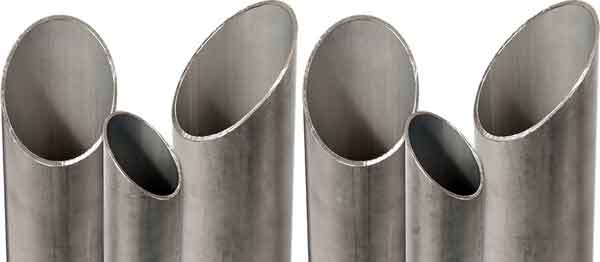 |
Hastelloy® Alloys |

Hastelloy® metals and alloys are known for their superior ability to withstand high temperatures and corrosion. Haynes International first developed this type of super alloys after the invention of stainless steel in 1913.
Hastelloy® alloys offer incredible strength and ductility under stress, as well as good formability. Hastelloy® alloys are resistant to corrosive chemicals and acids, such as hydrochloric acid, which sets them apart from other alloys. In addition, a metallurgist can make a superalloy so that it is resistant to oxidizing agents.
Corrosion-resistant Hastelloy® alloys
Hastelloy® B-3® Alloy
The Hastelloy® B-3® alloy (UNS N10675) exhibits extremely high resistance to pure hydrochloric acid, hydrogen bromide and sulfuric acid. Furthermore, it has greatly improved structural stability compared to previous B-type alloys, leading to fewer problems during welding, fabrication and maintenance.
Like other nickel alloys (in the annealed state), it is ductile, can be formed and welded, and resists stress corrosion cracking in chloride-containing solutions. Also, it can withstand fluoride-bearing media and concentrated sulfuric acid, both of which result in damage to zirconium alloys.
It is used in numerous applications of the chemical process industry, especially in the construction of reaction vessels for pure, reducing acid service.
Hastelloy® C-22® Alloy
Hastelloy® C-22® alloy (UNS N06022) is one of the well-known and proven nickel-chromium-molybdenum materials, whose key properties include resistance to both oxidizing and non-oxidizing chemicals, and protection against pitting, crevice attack and stress corrosion cracking.
The high chromium content offers much higher resistance to oxidizing media than the standard C-276 alloy, and provides exceptional resistance to chloride-induced pitting, an insidious and unpredictable form of attack to which stainless steel is susceptible.
Like other nickel alloys, Hastelloy® C-22® alloy is highly ductile, exhibits excellent weldability, and is readily fabricated into industrial components.
It is available in the form of plates, sheets, strips, billets, bars, wires, pipes, tubes and clad electrodes.
Typical applications in the chemical process industry include reactors, heat exchangers and columns.
Hastelloy® C-276 Alloy
Hastelloy® C-276 alloy (UNS N10276) was the first forged, nickel-chromium molybdenum material to address concerns about welding (based on its extremely low carbon, silicon).
As such, it became widely accepted in the chemical process industry and related industries, and it has long track records of proven performance in a wide range of corrosive chemicals.
Like other nickel alloys, it is ductile, easily formed and welded, and possesses exceptional resistance to stress corrosion cracking in chloride-containing solutions (a form of degradation to which austenitic stainless steels are susceptible).
With its high chromium and molybdenum content, it is resistant to both oxidizing and non-oxidizing acids, and exhibits excellent resistance to pitting and crevice attack in the presence of chlorides and other halides.
Furthermore, it is highly resistant to sulfide stress cracking and stress corrosion cracking and cracking in acidic, oilfield environments. Hastelloy® C-276 alloy is available in the form of plates, sheets, strips, billets, bars, wires, pipes, tubes and clad electrodes.
Typical chemical process industry applications include reactors, heat exchangers, and columns.
Standard Composition of Hastelloy® C-276
Ni
57.00% Balance
Cr
16.00%
Mo
16.00%
Fe
5.00%
W
4.00%
Mn
1.00% max
Cu
0.5% max
V
0.35% max
Si
0.08% max
C
0.01% max
Welding and fabrication of Hastelloy® C-276
Hastelloy® C-276 alloy is highly amenable to the Gas Metal Arc (GMA/MIG), Gas Tungsten Arc (GTA/TIG), and Shielded Metal Arc (SMA/Stick) welding processes. Fitting filler metals (i.e., solid wires and clad electrodes) are available for these processes.
Hastelloy® C-2000® alloy
Hastelloy® C-2000® alloy (UNS N06200) is unique among versatile nickel-chromium-molybdenum materials due to the deliberate addition of copper. This provides greatly enhanced resistance to sulfuric acid. It also has a high chromium content, for maximum resistance to oxidizing chemicals and process streams contaminated with iron ions and dissolved oxygen.
Like other nickel alloys, it is ductile, easily formed and welded, and possesses exceptional resistance to stress corrosion cracking in chloride-containing solutions (a form of degradation to which austenitic stainless steels are susceptible). It is resistant to a wide range of oxidizing and non-oxidizing chemicals, and exhibits excellent resistance to pitting and crevice attack in the presence of chlorides and other halides.
Typical applications in the chemical process industry are reactors and heat exchangers.
Hastelloy® G-30® alloy
Hastelloy® G-30® alloy (UNS # N06030) is a nickel-chromium-iron material that is highly resistant to "wet process" phosphoric acid (P2 O5), one of the most important industrial chemicals, being the primary source of phosphorus for agricultural fertilizers.
The G-30® alloy is also moderately resistant to chloride-induced localized attack, which can be a problem under deposits in evaporators used to remove P2 O5. In addition, G-30® is less susceptible to chloride-induced stress corrosion cracking than stainless steels. steels. As a result of its high chromium content, G-30® alloy is also highly resistant to other oxidizing acids, such as nitric acid and mixtures containing nitric acid. It possesses moderate resistance to reducing acids, such as hydrochloric and sulfuric acids, due to its significant molybdenum and copper content.
Hastelloy® G-30® alloy is available in the form of plates, sheets, strips, billets, bars, wires, pipes, tubes and clad electrodes.
Applications include P2 O5 evaporator tubes and nitric acid-based, metal stain-based hardware.
Reference(s) for this article..https://www.haynesintl.com/
On the Haynes website you will find more Hastelloy® grades with complete data sheets for each alloy.